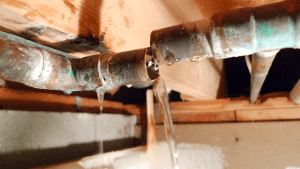How to Inspect If Your Residence Has a Covert Leakage
How to Inspect If Your Residence Has a Covert Leakage
Blog Article
They are making a few good pointers on the subject of Leaking water lines in general in this great article further down.

Early detection of leaking water lines can mitigate a prospective calamity. Some little water leakages may not be noticeable.
1. Analyze the Water Meter
Every home has a water meter. Inspecting it is a surefire way that assists you discover leaks. For starters, shut off all the water sources. Ensure nobody will purge, use the faucet, shower, run the washing device or dishwasher. From there, go to the meter and also watch if it will change. Since no one is using it, there need to be no movements. That indicates a fast-moving leak if it moves. If you discover no adjustments, wait a hr or two and inspect back once again. This implies you might have a slow leakage that could also be below ground.
2. Check Water Consumption
If you spot unexpected adjustments, regardless of your intake being the exact same, it indicates that you have leakages in your plumbing system. An unexpected spike in your costs shows a fast-moving leakage.
On the other hand, a steady boost on a monthly basis, despite having the same routines, shows you have a sluggish leakage that's also slowly escalating. Call a plumber to completely check your residential property, specifically if you really feel a cozy location on your flooring with piping underneath.
3. Do a Food Coloring Examination
When it involves water intake, 30% comes from bathrooms. Test to see if they are running effectively. Drop specks of food shade in the tank and also wait 10 minutes. There's a leakage in between the container and dish if the shade in some way infiltrates your bowl during that time without flushing.
4. Asses Exterior Lines
Don't forget to inspect your exterior water lines too. Should water seep out of the link, you have a loosened rubber gasket. One tiny leakage can lose tons of water and also increase your water bill.
5. Assess the circumstance and also examine
Homeowners must make it a routine to check under the sink counters and even inside closets for any kind of bad odor or mold development. These two warnings suggest a leak so timely focus is called for. Doing regular examinations, also bi-annually, can save you from a major issue.
If you understand your house is currently old, keep a careful eye on your heating units, pipes, pipelines etc. Look for discolorations and damaging as a lot of pipes and home appliances have a life span. They will likewise normally deteriorate because of damage. If you presume dripping water lines in your plumbing system, don't wait for it to intensify. Call a professional plumber right away so you do not wind up with a dreadful mess in your house.
Early discovery of leaking water lines can reduce a prospective calamity. Some small water leakages may not be visible. Inspecting it is a guaranteed way that aids you discover leaks. One little leak can squander bunches of water and also surge your water bill.
If you suspect dripping water lines in your plumbing system, do not wait for it to rise.
WARNING SIGNS OF WATER LEAKAGE BEHIND THE WALL
PERSISTENT MUSTY ODORS
As water slowly drips from a leaky pipe inside the wall, flooring and sheetrock stay damp and develop an odor similar to wet cardboard. It generates a musty smell that can help you find hidden leaks.
MOLD IN UNUSUAL AREAS
Mold usually grows in wet areas like kitchens, baths and laundry rooms. If you spot the stuff on walls or baseboards in other rooms of the house, it’s a good indicator of undetected water leaks.
STAINS THAT GROW
When mold thrives around a leaky pipe, it sometimes takes hold on the inside surface of the affected wall. A growing stain on otherwise clean sheetrock is often your sign of a hidden plumbing problem.
PEELING OR BUBBLING WALLPAPER / PAINT
This clue is easy to miss in rooms that don’t get much use. When you see wallpaper separating along seams or paint bubbling or flaking off the wall, blame sheetrock that stays wet because of an undetected leak.
BUCKLED CEILINGS AND STAINED FLOORS
If ceilings or floors in bathrooms, kitchens or laundry areas develop structural problems, don’t rule out constant damp inside the walls. Wet sheetrock can affect adjacent framing, flooring and ceilings.
https://www.servicemasterbyzaba.com/blog/how-to-detect-water-leakage-in-walls/

Hopefully you enjoyed reading our section on Locating water leaks. Thanks so much for taking time to browse our piece. Are you aware of another individual who is fascinated by the subject? Why not promote it. Thanks for your time. Don't hesitate to come by our blog back soon.
Report this page